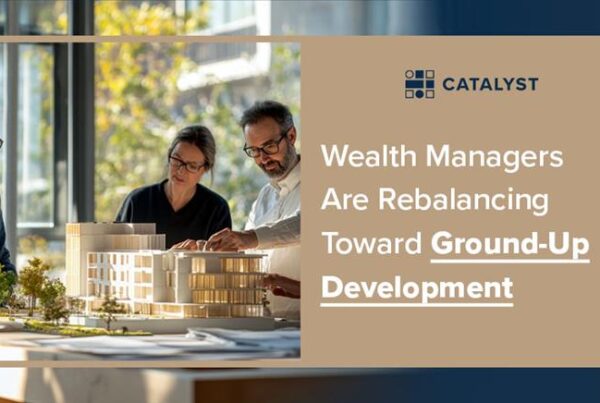November 17, 2025 | 4 min read
Why Wealth Managers Are Rebalancing Toward Ground-Up Development in 2026
Introduction
As yields tighten across traditional asset classes, leading U.S. wealth managers and advisory firms are increasingly shifting toward ground-up real estate development as part of their alternative investment portfolios for 2026. This strategy responds to structural market changes, investor demand for growth, and the appeal of value-creation opportunities.
For investors working with Catalyst, understanding this pivot is crucial for aligning with emerging opportunities and positioning for outperformance.
Why Ground-Up Development Is Gaining Attention?
a) Traditional Assets Under Pressure
Stabilized real estate assets in U.S. markets are trading at historically high multiples, compressing yields for investors. Wealth managers are looking to ground-up development to generate alpha.
The U.S. wealth management market’s assets under management (AUM) are projected to reach US$92.53 trillion in 2025. (Statista, 2025)
Meanwhile, alternative asset classes — including private equity, venture capital, and real estate development — are expected to grow at a CAGR of 14.67% through 2030. (Mordor Intelligence, 2025)
b) Growing Demand and Limited Supply
In high-growth U.S. metro areas, new real estate supply is limited while demand remains strong. This imbalance creates opportunities for higher returns through ground-up development, where value is built rather than bought.
c) Investor Appetite for Alternatives
High-net-worth individuals increasingly expect wealth managers to provide access to alternative investments beyond equities and fixed income. In the U.S., alternative real estate investments have delivered annualized returns of 11.6%, compared to 6.2% for traditional assets. (Deloitte, 2025)
What Ground-Up Development Means for Investors?
Ground-up development refers to acquiring land or underutilized assets, securing entitlements, designing, and constructing new real estate projects—residential, commercial, or mixed-use.
This strategy offers:
- Value creation through entitlement, design, and leasing premiums.
- Early access to the real estate value chain.
- Potential for higher returns than stabilized assets (with higher risk).
For U.S. wealth managers targeting growth markets, ground-up development provides a clear differentiator and early access to long-term value creation.
Strategic Reasons Wealth Managers Are Rebalancing Now
• Yield Challenges in a Low-Rate Environment
Interest rates remain elevated, and competition for core assets is high. Development offers access to higher return spreads.
• Portfolio Diversification
Including ground-up development enhances diversification, allowing investors to participate in construction, lease-up, and eventual sale, rather than just holding stabilized properties.
• Strategic Timing
Many U.S. managers believe delivering ground-up assets between 2026 and 2028 positions portfolios to capture the next demand cycle.
• Meeting Client Expectations
Clients expect modern, growth-oriented investment strategies. A survey by Natixis Investment Managers found that U.S. wealth managers expect average AUM growth of 17.6% in 2025, higher than the global average of 13.7%. (Natixis IM, 2025)
Key Market Data and Trends
- U.S. Wealth Management Market AUM (2025): US $92.53 trillion
- Alternative Assets CAGR (2025–2030): ~14.67%
- U.S. Real Estate Returns: Ground-up alternatives 11.6% vs stabilized assets 6.2%
- Institutional Real Estate Market (2023–2034): Growth from US $76.76 trillion to US $115.45 trillion (Precedence Research, 2025)
These data points highlight the urgency for wealth managers to diversify and explore development-based investment strategies in the U.S. market.
Implications for Investors and Local Markets
For Investor Clients
- Target growth-oriented submarkets with strong employment, infrastructure, and demographic trends.
- Understand timelines: development takes longer but can deliver superior returns.
- Ensure alignment of interests with sponsors who co-invest.
- Use development as a complement, not a replacement, for stabilized assets.
For Wealth Managers
- Incorporate development-stage investments into client portfolios.
- Educate clients about risks and return horizons.
- Build regional partnerships (e.g., with Catalyst) to access local deals.
- Use data-driven analysis to identify attractive markets and mitigate risk.
How Catalyst Adds Value
Catalyst specializes in build-to-create real estate strategies. By leveraging U.S. market expertise, we source land and entitlement opportunities, partner with proven developers, and structure investments to align with investor objectives.
Benefits of working with Catalyst:
- Access to early-stage development opportunities is not widely available.
- Transparent reporting on project progress, budgets, and lease-up status.
- Disciplined risk management focused on value creation.
Key Risks and Considerations
- Construction cost inflation and supply-chain disruptions
- Regulatory or entitlement delays
- Market demand risk: ensuring absorption meets expectations
- Exit risk: clear plan post-stabilization
- Liquidity risk: development investments are less liquid than core holdings
With proper structuring, ground-up development can be a high-performing alternative asset for diversified portfolios.
Conclusion
The U.S. shift toward ground-up development in 2026 reflects fundamental market changes, tight yields, limited inventory, and a growing appetite for value creation.
For investors partnering with Catalyst, this evolution presents a timely opportunity to participate in the next wave of real estate growth, with disciplined underwriting, local expertise, and transparent execution.
If you’re a wealth manager or investor seeking to diversify into high-growth, ground-up development opportunities, contact Catalyst today to explore projects that align with your portfolio goals.
Join Us
Subscribe to our newsletter.



